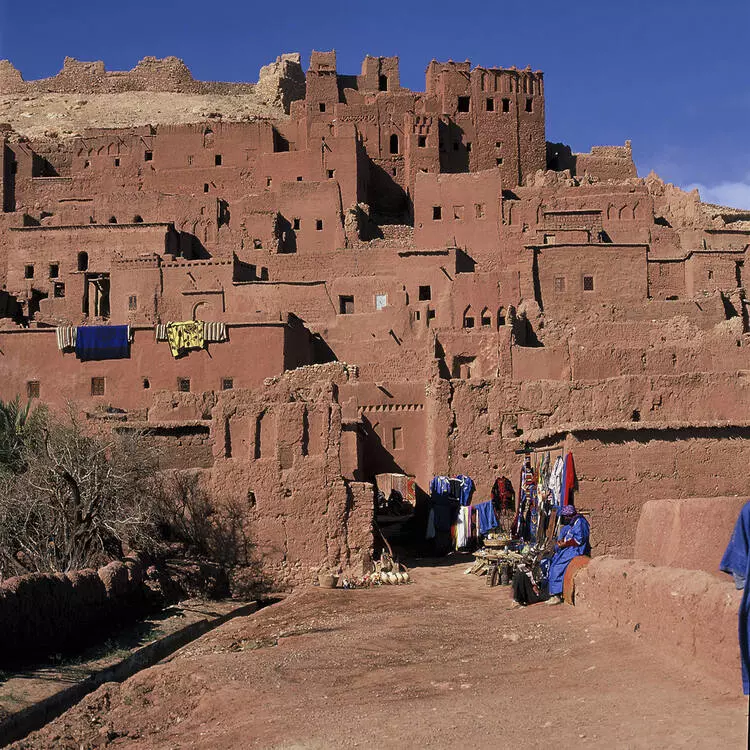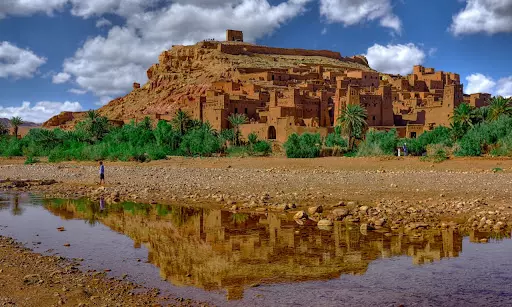The Kasbah AIT BEN HADDOU
The palace of Ait Ben Haddou, built ten centuries ago, still stands tall in the village of the same name, thirty kilometers from the center of the city of Ouarzazate in the southeast of Morocco, where its role and kasbahs cling to the slope of a large plateau overlooking the Unla River, with its walls, mud towers, small windows, and narrow and twisting alleys.
The palace welcomes visitors from the other side of the Unla River with a newly constructed concrete vault. As soon as the visitor passes through the arch, he finds himself between the palace’s walls, and it’s only a few steps until he comes face to face with an iron plaque that reads, “The Palace of Ait Benhaddou Welcomes You,” and another with a design for the palace. Following that was a long alley lined with shops selling antiques, pots, and old ornaments, as well as a number of Moroccan and foreign tourists.
Geographical location
It is located 30 kilometers north-west of Ouarzazate in the rural commune of Ait Zeinab, in the department of Amrazghan. It was built on the southern side of Taourirt Negram hill on the eastern bank of Asif Margin in the Onila Valley, which served as a trade caravan transit route between the desert areas and the Mediterranean coasts.
History of kasbah AIT BEN HADDOU
The Kasbah AIT BEN HADDOU’s geographical location on a major commercial hub made it a target for the various ruling dynasties that followed Morocco. According to the novel, the first facility in the Kasbah was Igram Niqdarn, which was led by a Berber princess of Jewish origin (similar to the priestess), whose rule extended all the way to the Souss region. The village notary left a document stating that the Ait Issa or Hammad tribe founded the first nucleus of the kasbah in the twelfth century AD, and it will join General “Ben Haddou” appointed by Almorabit Sultan Yusuf bin Tashfin to establish security in this area known for the activity of its trade convoys and tribal conflicts. According to studies, the oldest antiquities in the Kasbah date back to after the seventeenth century AD, and the novel also claims that the area was occupied by the Portuguese state at the time. The Kasbah was the seat of the honorable elders’ caliphate and played an important role in representing the Makhzen’s influence in the region during the nineteenth century AD.
During the last movement he led between 1893-1894AD, Sultan Hassan I passed through the region to join Tlawat and then Marrakesh, and appointed Al-Basha Al-Kalaoui as governor of the south, who met resistance from the Ait and Ozgate tribes, except for the Ait Haddou tribes, which had relations with the Kalaoui. During the period of protection, the Kasbah AIT BEN HADDOU was easily occupied as a result of the support provided by the new Pasha of Marrakesh, Tohami El Klaoui, forcing the tribes of Ait Ben Haddou to fortify in the Kasbah throughout the colonial period, hence the nickname “Mont Saint-Michel de Chlouh” (le Mont Saint Michel des Chleuhs). Only with the advent of independence were the residents able to establish the new village on the eastern bank of Asif Marghan.

AIT BEN HADDOU AESTHETICS
Ait Benhaddou Palace, designated as a world heritage site by the United Nations Educational, Scientific, and Cultural Organization “UNESCO” in 1987, is a 1,300-square-meter architectural edifice pierced by many narrow alleys in length and width, intertwined in a unique geometric form.
Station on the caravan route
According to Abdel Karim Al-Tazarni, a researcher in Moroccan southern history, the Ait Ben Haddou Palace is a model of mud architecture in southern Morocco, and it was built in its current form during the eighteenth century. However, some archaeologists believe that it was built for the first time during the Almoravid state in the eleventh century AD, as it is believed that a person named Amghar Benhaddou lived there during the Almoravid rule in the same century, explaining that the palace served as a stopover for trade caravans traveling between Marrakesh and Sudan at the time.
According to the historian, the construction of the palace on a hill overlooking the valley was not done arbitrarily, but rather as a strategic choice, which includes security reasons represented by the fact that the area is naturally fortified, not to mention that entry and exit from the palace were carried out through two gates in order to monitor the movements around the palace’s perimeter. The site was chosen for economic reasons, as evidenced by the use of river water for agriculture.
Several facilities in the palace are still operational. The mosque in the center has walls that match the walls of the houses. It includes a well, restrooms, and a Quranic school. The “collective square” in the palace’s center is where residents used to gather for family and religious occasions, and the “collective warehouse” at the top of the hill was used to store grain.
Quick links to choose a Sahara Tours from Marrakech :
Although UNESCO’s designation of the Ait Ben haddou Palace as a world heritage site necessitates caution to protect it from disappearance and distortion, the restoration process appears to be slow, as the effects of time can still be seen on many of the walls and houses. The migration of local residents to their homes made the restoration even more difficult, as they were restoring their homes with their own hands whenever possible. While some historical sources indicate that approximately 98 families lived in the palace until 1940, the delegation found only five families during its visit to the Middle East, one of whom turned her home into a café serving tea and coffee on a traditional bed.
Tourism and film
Muhammad was in his early forties at the time. Asharq Al-Awsat met him in front of his shop, which sold gifts, antiques, and antique utensils. He turned and said, “Hello, sir,” after saying goodbye to a French tourist who had purchased a small souvenir.
“I am not a resident of the place, but I live in a village about 8 kilometers away, and I own this shop, which does not exceed an area of ten meters,” Mohammed says, noting that his customers are Moroccans and people of various nationalities, but “Europeans visit the palace a lot.” The palace’s spaces have appeared in many historical films, including “The Mummy” and “Gladiator” by British director Ridley Scott, and “Alexander” by American director Oliver Stone, among others. The palace of Ait Ben haddou bids farewell to his visitors with the same view and loftiness that he received them, after shortening them a lot of Moroccan architecture and culture. As one of the visitors put it, sitting on a roofed terrace in a narrow alley is enough to see how the first Moroccans used to meet to discuss tribal affairs.


